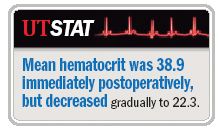Article
Laparoscopic approach to hemorrhage management 'feasible'
Initial experience with laparoscopic management of post-urologic surgical hemorrhage suggests its feasibility as a minimally invasive alternative to open laparotomy.

Keypoints:
Anaheim, CA-Initial experience with laparoscopic management of post-urologic surgical hemorrhage suggests its feasibility as a minimally invasive alternative to open laparotomy, according to urologists from the University of Chicago.

The three patients who comprised the series were identified through a chart review of almost 700 laparoscopic urologic procedures performed from 2002 to 2006 by a single surgeon, Arieh L. Shalhav, MD.
None of the three patients with postoperative hemorrhage required further transfusion after undergoing laparoscopic exploration and management, reported first author Edward M. Gong, MD, a urology resident at the University of Chicago. Their hospital stay after the secondary procedure ranged from 1 to 3 days.
"Use of laparoscopic surgery to manage abdominal emergencies is well described, but only recently has this technique been used for intervention in acute postsurgical complications," Dr. Gong said of the procedure. "Ours is a small report, but the findings suggest that in select patients, hemorrhage can be efficiently treated via laparoscopy, allowing patients to avoid the morbidity of open exploration and maintain the benefit of their original minimally invasive procedure."
The primary procedure was robot-assisted laparoscopic radical prostatectomy in two patients and laparoscopic radical nephrectomy in the third. Mean hematocrit for the group was 38.9 immediately postoperatively, but it decreased over time to 22.3, and transfusion with five to eight units of blood (mean, 6.3 units) was given at a mean of 19.4 hours after the primary surgery. One patient who had undergone radical prostatectomy developed orthostasis and hypotension, despite transfusion. The other two men maintained stable vital signs, but they had a history of coronary artery disease and their hematocrit continued to decrease after transfusion.
The patient who developed signs of hemodynamic instability was found on laparoscopic exploration to have an abdominal wall arterial bleed at the prostate extraction site and oozing from the dorsal venous complex. The abdominal wall arterial bleeder was controlled with suture ligation and the other site was addressed by further cinching of the Lapra-Ty clip (Ethicon Endo-Surgery, Cincinnati) on the dorsal venous stitch, as previously described.
The second patient who had undergone robot-assisted laparoscopic radical prostatectomy was bleeding from the neurovascular bundle.In this case, bleeding was managed by use of a hemostatic sealant (FloSeal, Baxter, Deerfield, IL) and placement of Surgicell (Johnson & Johnson, Somerville, NJ) in the prostatic fossa.
Finally, the patient who had previously undergone laparoscopic radical nephrectomy had arterial bleeding in the posterior renal fossa that was controlled by suture ligation.
Dr. Gong explained that all patients came to laparoscopic surgical exploration for their postoperative bleeding based on an existing management algorithm. In that algorithm, bleeding is initially suspected based on changes in vital signs and potentially increased drain output, but it is ultimately defined by serial decrease in hemoglobin and hematocrit.
The management algorithm bifurcates on the basis of whether the patient is hemodynamically stable. Patients who are unstable receive immediate fluid resuscitation and undergo emergent open surgical exploration. However, conservative management is tried initially for stable patients by using fluid resuscitation, blood transfusion, and identification and correction of any coagulopathy, accompanied by ongoing clinical assessment.
"These strategies are typically successful in stabilizing the hematologic parameters and vital signs. However, a small subset of patients fail to respond adequately to the conservative measures, and will have falling hematocrit, clinical evidence of ongoing bleeding, and, ultimately, impending hemodynamic instability that becomes an indication for laparoscopic exploration," Dr. Gong said.
Newsletter
Stay current with the latest urology news and practice-changing insights — sign up now for the essential updates every urologist needs.
















